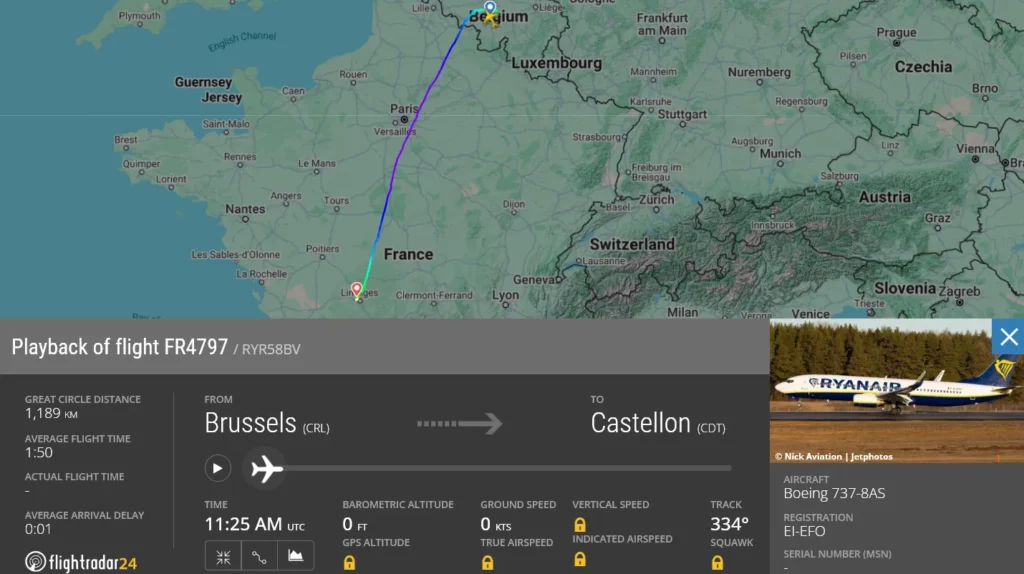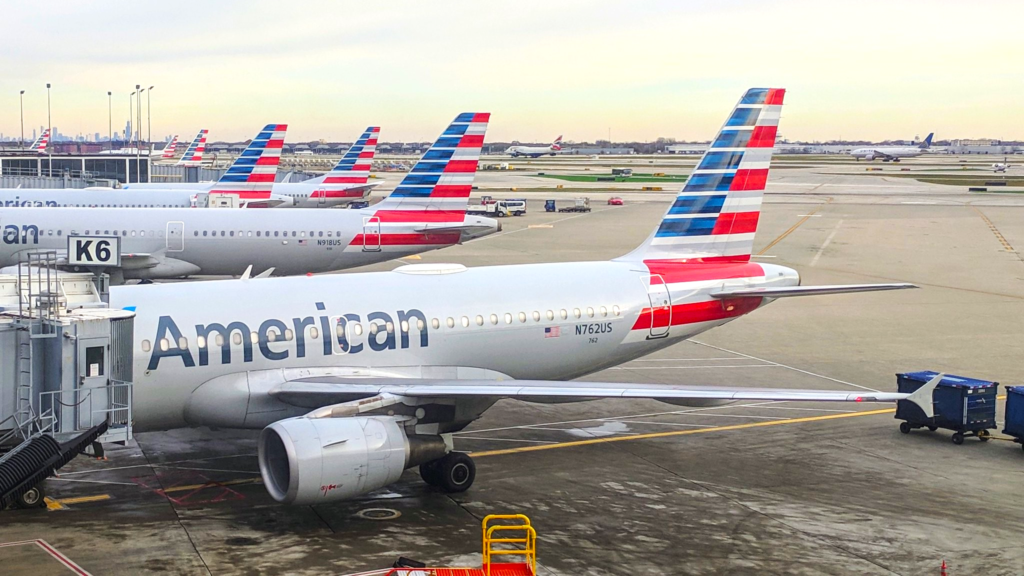
BRUSSELS- A Ryanair (FR) flight FR4797, from Brussels Charleroi (CRL) to Castellón (CDT), made an unscheduled landing in Limoges, France (LIG) on May 8, 2025, after a passenger gave birth to a baby girl while the aircraft cruised at 18,000 feet.
The Boeing 737-800, which departed Brussels (CRL) at 13:30 UTC, diverted when the medical emergency unfolded over central France, landing safely at Limoges airport (LIG) at 12:35 UTC where emergency services awaited their arrival.
 Photo- Flightradar24
Photo- Flightradar24Babies Born Onboard
This recent incident joins a growing list of babies born during commercial flights.
In September 2021, a Moroccan passenger delivered a child during a Turkish Airlines (TK) flight between Istanbul (IST) and Chicago (ORD).
July 2019 saw another birth on a flight from Doha (DOH) to Beirut (BEY), prompting a diversion to Kuwait (KWI) for emergency medical attention.
During the 2021 U.S. evacuation from Afghanistan, an Afghan evacuee gave birth aboard a C-17 military aircraft.
 Photo- Instagram User; Compiled by Aviation A2Z
Photo- Instagram User; Compiled by Aviation A2ZHow Airlines Handle In-Flight Births
Airlines prepare flight crews extensively for medical emergencies, including childbirth. When a passenger goes into labour, the cabin crew implement specific response protocols designed to ensure safety for both mother and newborn.
The process begins with a rapid assessment. Crew members evaluate the passenger’s condition and determine birth immediacy. If delivery appears likely before the aircraft can land, the crew alerts the pilots, who may initiate a diversion to the nearest airport with appropriate medical facilities.
Communication Framework
Flight crews utilise a structured communication system called NITS during such emergencies:
- Nature of the problem (passenger in labour)
- Intentions of the crew (potential diversion)
- Time available (estimated arrival at nearest suitable airport)
- Special instructions (cabin preparation, medical assistance requests)
This framework ensures clear communication between the cockpit and the cabin during non-routine situations like mid-air births.
Managing Birth at Altitude
When no medical professionals are among the passengers, the cabin crew assume responsibility for delivery. They create a makeshift private area, typically in the rear galley, and utilise the aircraft’s emergency medical kit, which contains gloves, blankets, and basic medical supplies.
Following established childbirth protocols, crew members coach the mother through delivery, receive the newborn, and, if necessary, cut the umbilical cord.
After birth, they monitor both mother and infant, maintaining warmth and stability until landing, when ground medical personnel take over care.
The airline requires detailed documentation of the incident, including actions taken and outcomes observed.
 Photo- Air New Zealand
Photo- Air New ZealandCitizenship for Airborne Births
Despite popular belief, babies born in flight rarely receive citizenship from the country whose airspace the aircraft occupied during birth. The legal reality proves more complex, involving multiple determining factors.
Several principles guide citizenship assignment for in-flight births:
1. Parental Nationality
Most nations follow “jus sanguinis” (right of blood), granting citizenship based on parental nationality regardless of birth location. This principle typically provides the most straightforward path to citizenship for babies born during flights.
2. Aircraft Registration
Every aircraft carries the nationality of its country of registration. This factor becomes relevant primarily when a baby would otherwise remain stateless, when neither parental nationality nor territorial principles apply.
3. Territorial Airspace
Some countries extend “jus soli” (right of soil) principles to their territorial airspace, potentially granting citizenship to anyone born within these boundaries.
For births occurring over international waters, outside any national airspace, the aircraft’s registration country might determine citizenship, but only if parental nationality and other territorial principles fail to provide a pathway to citizenship. These situations remain exceedingly rare, as most nations’ citizenship laws adequately address such cases through either parental lineage or territorial claims.
 Photo- Tui Airlines
Photo- Tui AirlinesAirline Policies
Most airlines maintain policies restricting travel for women in advanced pregnancy stages. These typically prohibit flying after 36 weeks of gestation for single pregnancies and earlier for multiple pregnancies.
Many carriers require medical certificates for passengers between 28-36 weeks pregnant.
Despite these precautions, unexpected deliveries still occur, sometimes due to premature labour or miscalculated due dates. Airlines continuously refine their training programs to prepare crew members for these rare but significant events.
 Photo: James Cridland | Flickr
Photo: James Cridland | FlickrMedical Challenges
Births at cruising altitude present unique medical challenges-
- Reduced cabin pressure
- Limited medical equipment
- Space constraints
- Potential turbulence
Additionally, the dry cabin environment potentially increases dehydration risk for the mother.
Commercial aircraft medical kits contain basic delivery supplies but lack specialised neonatal equipment. This reality underscores the importance of diversion to ground-based medical facilities whenever possible.
 Photo- Nexus Airlines
Photo- Nexus AirlinesBottom Line
As air travel continues expanding globally, airlines increasingly focus on enhancing medical emergency response capabilities. This includes more comprehensive medical kits, expanded crew training for childbirth scenarios, and improved coordination with ground-based medical consultation services.
While babies born during flights remain relatively rare, each case represents a remarkable convergence of extraordinary circumstances, quick-thinking airline professionals, and the unpredictable timing of human birth—truly miracles at 18,000 feet!
Stay tuned with us. Further, follow us on social media for the latest updates.
Join us on Telegram Group for the Latest Aviation Updates. Subsequently, follow us on Google News
Brussels Airlines Flight Attendant Delivers Baby Mid-Air on A330
The post How Airlines Handle In-Flight Baby Births? appeared first on Aviation A2Z.













